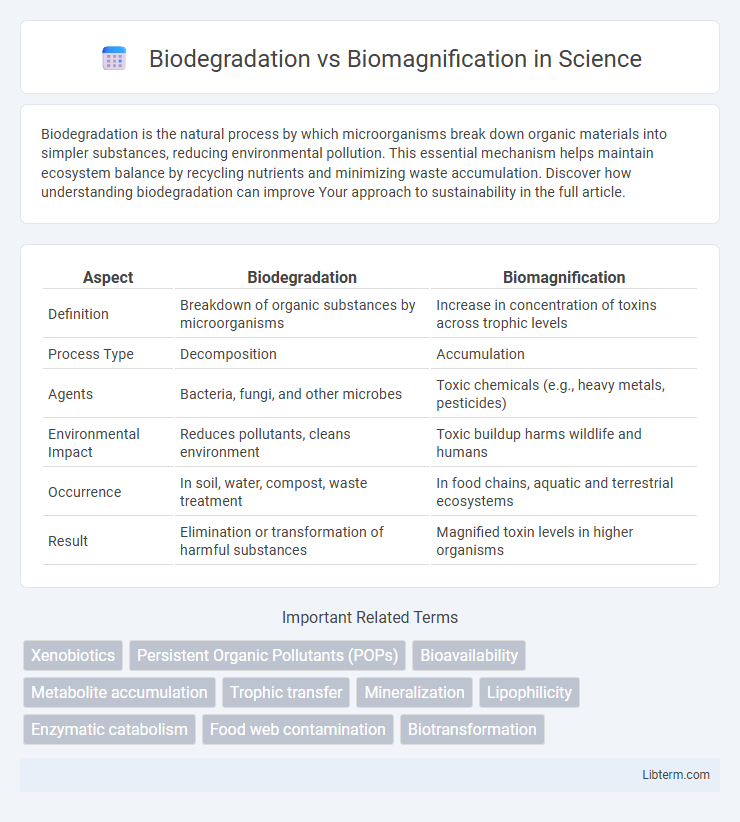Biodegradation is the natural process by which microorganisms break down organic materials into simpler substances, reducing environmental pollution. This essential mechanism helps maintain ecosystem balance by recycling nutrients and minimizing waste accumulation. Discover how understanding biodegradation can improve Your approach to sustainability in the full article.
Table of Comparison
| Aspect | Biodegradation | Biomagnification |
|---|---|---|
| Definition | Breakdown of organic substances by microorganisms | Increase in concentration of toxins across trophic levels |
| Process Type | Decomposition | Accumulation |
| Agents | Bacteria, fungi, and other microbes | Toxic chemicals (e.g., heavy metals, pesticides) |
| Environmental Impact | Reduces pollutants, cleans environment | Toxic buildup harms wildlife and humans |
| Occurrence | In soil, water, compost, waste treatment | In food chains, aquatic and terrestrial ecosystems |
| Result | Elimination or transformation of harmful substances | Magnified toxin levels in higher organisms |
Introduction to Biodegradation and Biomagnification
Biodegradation is the natural process by which microorganisms break down organic substances into simpler compounds, reducing environmental pollutants and promoting ecosystem health. Biomagnification refers to the increasing concentration of toxic substances, such as heavy metals or pesticides, in organisms higher up the food chain, posing severe risks to wildlife and human health. Understanding the mechanisms of biodegradation and biomagnification is essential for developing effective environmental protection and pollution control strategies.
Definitions: What is Biodegradation?
Biodegradation is the natural process by which microorganisms, such as bacteria and fungi, break down organic substances into simpler compounds, ultimately converting pollutants into harmless materials like water, carbon dioxide, and biomass. This process plays a crucial role in environmental cleanup by reducing the persistence of hazardous chemicals in soil and water ecosystems. Unlike biomagnification, which refers to the increasing concentration of toxins up the food chain, biodegradation helps in the effective breakdown and removal of contaminants from the environment.
Definitions: What is Biomagnification?
Biomagnification refers to the progressive increase in the concentration of toxic substances, such as heavy metals or persistent organic pollutants, in organisms at successive trophic levels of a food chain. Unlike biodegradation, which involves the breakdown of contaminants by biological processes into less harmful forms, biomagnification results in higher toxin levels accumulating in apex predators, posing significant ecological and health risks. This phenomenon highlights the persistent nature of certain pollutants and their ability to move and amplify through ecosystems without being degraded.
Key Differences Between Biodegradation and Biomagnification
Biodegradation involves the natural breakdown of organic substances by microorganisms into simpler compounds, reducing environmental pollutants. In contrast, biomagnification refers to the increasing concentration of toxic substances, such as heavy metals or pesticides, in organisms higher up the food chain. Key differences include biodegradation's role in pollutant reduction versus biomagnification's amplification of toxins, and the biological agents involved: microbes in biodegradation and trophic-level accumulation in biomagnification.
Environmental Impact of Biodegradation
Biodegradation plays a crucial role in reducing environmental pollution by breaking down organic pollutants into harmless substances, thereby minimizing toxic buildup in ecosystems. This natural process supports soil health, improves water quality, and enhances the sustainability of waste management systems by preventing the accumulation of persistent contaminants. In contrast, biomagnification increases the concentration of harmful substances like pesticides and heavy metals in higher trophic levels, posing severe risks to wildlife and human health.
Ecological Effects of Biomagnification
Biomagnification causes toxic substances like heavy metals and persistent organic pollutants to accumulate at higher concentrations in organisms higher up the food chain, leading to severe ecological imbalances. This accumulation disrupts reproductive systems, weakens immune response, and leads to population declines among predators, including birds of prey and apex marine species. In contrast to biodegradation, which breaks down contaminants into less harmful forms, biomagnification amplifies ecological risks and long-term environmental toxicity.
Factors Influencing Biodegradation
Biodegradation is influenced by factors such as temperature, pH, oxygen availability, and the presence of specific microbial communities capable of breaking down pollutants. Organic matter composition and pollutant bioavailability also play critical roles in the efficiency of microbial degradation processes. Unlike biomagnification, which involves the accumulation of toxins through the food chain, biodegradation relies on environmental conditions that enhance microbial metabolic activity to reduce contaminant levels.
Common Examples of Biomagnification
Biomagnification occurs when toxic substances like mercury, DDT, and PCBs increase in concentration as they move up the food chain, affecting top predators such as sharks, birds of prey, and humans. Unlike biodegradation, which involves the breakdown of pollutants by microorganisms, biomagnification results in the accumulation of harmful chemicals in organisms, leading to severe ecological and health impacts. Common examples include mercury accumulation in fish and DDT concentration in bald eagles, causing reproductive failures and population declines.
Strategies to Promote Biodegradation and Prevent Biomagnification
Strategies to promote biodegradation center on enhancing microbial activity through biostimulation and bioaugmentation, which accelerate the natural breakdown of pollutants like hydrocarbons and pesticides. Preventing biomagnification involves reducing the release of persistent organic pollutants (POPs) such as PCBs and DDT into ecosystems by implementing stricter regulations and promoting alternatives with lower bioaccumulative potential. Environmental management techniques, including phytoremediation and constructed wetlands, facilitate pollutant degradation while limiting toxin transfer through trophic levels, thereby mitigating biomagnification risks.
Conclusion: The Importance of Understanding Both Processes
Understanding both biodegradation and biomagnification is essential for effective environmental management and pollution control. Biodegradation breaks down pollutants into less harmful substances, reducing environmental toxicity, while biomagnification concentrates toxins through food chains, posing severe risks to ecosystems and human health. Comprehensive knowledge of these processes enables the development of targeted strategies to mitigate contamination and protect biodiversity.
Biodegradation Infographic

 libterm.com
libterm.com